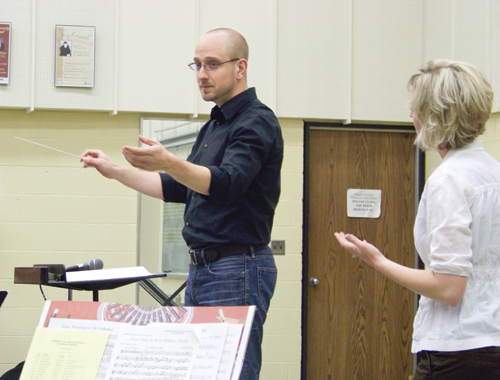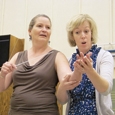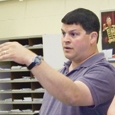
Conducting is among the most extensively used skills required of directors. Clear and expressive conducting provides a coordinated guide for the interpretation of style, phrasing, form, tempo, and dynamics of a musical work. In an effort to help ensembles succeed, many conductors resort to gestures and rehearsal habits that seem effective at the time, but more often than not are detrimental to the performance of the music and to the development of the musicians.
It is not surprising that directors pick up these habits over the course of their careers. Undergraduate music education programs rarely have time for more than one or two semesters of conducting. As new teachers enter the profession, the limits of their skills quickly become apparent. While some have colleagues at hand to help, others find themselves searching for their own solutions.
Obvious Gestures
Obvious gestures may be overused to the point of becoming meaningless or provide excessive information. These gestures remind musicians about information they already should know or be responsible for learning. Sometimes, you will see directors give a four-measure count off in rehearsals, even though college conducting classes teach a single prep beat. Some directors say the count off helps students know the tempo and be ready to play on the down beat. However, students should take the responsibility for paying attention to the conductor and learning tempo from a single prep beat.
In most cases tempo can be conveyed in one beat, although it requires a certain amount of proficiency and consistency. A good preparatory beat begins from a still position. The conductor finds a precise point of departure and an even preparatory motion. I recommend that students practice looking into a mirror and moving their right hand into position with the baton. They should strive for a nice up-and-down preparatory motion.
One of the best ways to train students to pick up the tempo is to have them breathe with the prep beat. They should learn this skill in 6th or 7th grade. The earlier they learn it, the more at ease they become with that type of motion. As you are teaching the group, it doesn’t hurt to make sure that they are all reacting in the same way, even the percussionists. They could even add a small horn motion, raising the instrument slightly as they breathe, to show that they are all reacting at the same time. After that, the key is repetition and high expectations.
Another explanation for extended count-offs stems from classroom management problems. Ensemble members have a responsibility to the conductor and other players to be ready to play when instructed. When directors use extended count-offs to get students’ attention, they are actually rewarding students who are not acting as they should. This habit actually encourages this undesirable behavior. Classroom management problems should be dealt with in ways that do not affect the communication of conducting.
Many directors make the mistake of altering their conducting patterns to help guide students through difficult rhythms. I have regularly observed this when ensembles prepare to work on sections with extensive syncopation. The director might start by indicating a pattern, but eventually will alter it to direct the placement of the syncopation. Initially, this attempt to conduct rhythms may yield some benefits. However, these results will become less prevalent as the rhythms grow more difficult. The ability to maintain tempo while manipulating note lengths and handling metric subdivisions takes considerable effort. There are no shortcuts for true skill with rhythm.
In addition, altering the pattern to conduct rhythms can cause the tempo to fluctuate while students give a delayed response to the gestures. Under this approach students are not reading rhythms for themselves, and their rhythms do not fit a consistent tempo. There are many great strategies for teaching rhythm through singing, clapping, counting, and tonguing. These proven methods will help students actively recognize rhythms without guidance from the podium.
Time beating is the most common bad habit found in conductors at all levels and often begins in university conducting classes. Music students learn conducting patterns for the most common meters and are encouraged to become so fluent that they hardly need to think about them. However, this repetition of patterns becomes a default for conductors.
There are definitely instances when beating time is essential for a successful performance. I learned this lesson the hard way at a conducting workshop. For the first two days, the participants were frequently reminded not to beat time. On the second night I resolved that the clinicians were not going to tell me to stop beating time no matter what. I was absolutely determined.
I practiced hard and the next day, I didn’t conduct time or give beats. The problem was, I had chosen the Stravinsky Octet to conduct that day. The clinician came up to me after I had done part of the movement and said, “you have to give them some time.” I realized that it wasn’t about beating time, it was about giving the ensemble what it needed. This was one situation where precise beats were important.
With other music if we are merely providing a beat and the ensemble doesn’t need the beat, then we really are not contributing to the performance. Sometimes, I have tried starting the ensemble and then stepped aside to let them play; the results have frequently been amazing. It can be a great source of pride to see what your musicians can do without your assistance. However, if ensembles do not need help with the basics, this should be seen as an opportunity to push students to greater musical expression in style, dynamics, and phrasing. In other instances, the best option is to get out of the way and let the ensemble make music.
Overworked Gestures
Gestures from the podium can easily become excessively large, labored, or complicated. While these exaggerated movements are intended to elicit specific responses, the opposite effect can result. Excessively large gestures are often used when working with large ensembles and may seem justified in a desire to ensure that everyone can see the conductor. However, the problem usually is not the ability to see, but the effort and attention that students give to watching. I was conducting an all-city band made up of every person who was in band from 5th grade to 12th grade in the entire school system. I was standing on a stack of podiums about six feet in the air, looking out on a gym with about 400 students. I had to think about how to deal with such a large group. In times like this, it is tempting to use motions that resemble parking a big jet at the airport. Instead, I stopped, got into position, and waited to get the ensemble’s attention. I gave an ordinary prep beat, and the massive band read it beautifully. Despite the size of the ensemble, it didn’t have to change my conducting. It was more about making sure that the ensemble was paying attention and was ready to go.
Defining the appropriate size for a conducting pattern depends on who you ask. For me, a normal-size conducting pattern is one that stays within the range of the torso. When I put a hand out in front, I like to place it just under the sternum. To me a normal size pattern wouldn’t go much above the shoulders, and it wouldn’t go really far to the right or left of the body. It would stay somewhat contained. That way, you can save the extremes for when you really want them in very specific types of musical moments.
Furthermore, the large size makes tempo and expressive changes far more difficult to communicate, and the extraordinary effort required on the part of the conductor can lead to fatigue and physical problems in the back, neck, and shoulders. The physical well-being of the conductor is worth the effort of teaching an ensemble how to watch.
Subdivision
Learning to subdivide evenly can prove a difficult task for many musicians. Some directors try to help players by showing perpetual subdivision. This is most common in moderate to fast tempos and simple meters (especially those subdivided into two equal parts such as 4/4 or 2/2 time). However, because the director places an ictus not only on the beats but on the subdivisions as well, this leads to choppy conducting. The heaviness of this gesture and reduced clarity of the pattern will usually slow down the ensemble, and the placement of the subdivisions will vary among musicians struggling to interpret the placement of each ictus.
As with difficult rhythms, musicians should learn to subdivide and feel the meter on their own. No conductor can make someone feel the subdivision. Teachers can use a combination of movement, singing, counting/rhythmic solfege, and audiation to help students develop subdivision skills. These techniques are best practiced while reading a basic and consistent tempo pattern showing only downbeats.
This does not mean conductors should never show subdivision. In some cases subdivision can clarify the pace of extremely slow tempos, regulate the change in a rallentando, or communicate a particularly expressive moment. Here the conductor makes a conscious choice to subdivide for a specific musical need. When the subdivision is no longer needed to help the players, it should vanish.
Accelerando
Tempo changes can be difficult for ensembles, and often conductors work harder than necessary to communicate these changes. Sometimes a director begins an accelerando, but the ensemble is a little behind the pace. To encourage the players to reach tempo, the conducting pattern becomes larger and larger to try to pull every bit of acceleration from the ensemble as possible. However, this increase in the size of the pattern does nothing to improve the clarity of the tempo change. In fact, large motions are instinctively interpreted as slower, so this tends to elicit the opposite response. When an ensemble is watching the conductor, sluggishness in tempo acceleration has more to do with uneasiness with the pace of change than with responsiveness to change. So often, the best way to communicate an increase in tempo is to decrease the size of the pattern and focus on precision of ictus placement and even pacing of the accelerando.
Anticipating Problems
There are several things conductors can do to anticipate when bad habits will arise and prepare to avoid them. The good news is that they are things that conductors should already be doing. First, study the music. Careful score study will reveal areas in the music where habits may tend to manifest as well as places where the ensemble will need assistance. This knowledge allows conductors to anticipate how they will to respond to these potential difficulties.
Know your ensemble. As directors select music and plan rehearsals, they should consider the strengths and weaknesses of the ensemble. Select music appropriate for musical growth while maintaining a high level of musical achievement and performance quality. The better a director knows an ensemble, the better he will be able to understand what the musicians need from the podium. Regularly assess the progress of the ensemble. As rehearsals continue and students become more confident, there will some places where the assistance of the director is no longer needed and opportunities for further growth in others.
Videotaping rehearsals
One of the best ways to monitor conducting habits and identify areas for improvement is through regular videotaping. When I am reviewing a tape, I pay particular attention to whether a piece starts with a good prep beat. Sometimes it helps to turn off the sound and just observe the visuals. You can always turn the sound back on later to see if the ensemble reacted in the way you wanted.
I also watch for potentially distracting motions; for example, conductors may notice that the center of their gesture shifts because of movement on the podium. If something seems off, the left hand may be in the way. Colleagues and former instructors can also give valuable objective feedback on what they observe in a video. Even if you live in the middle of nowhere, there are usually other musicians who can help.
There is an old saying that is heard in countless conducting classes: Less is more. When in doubt, conductors should step back and leave room for their ensembles to make music. When a clear need arises, something can always be added, but sometimes doing less and doing it well is the most effective method of conducting an ensemble and avoiding pitfalls.






